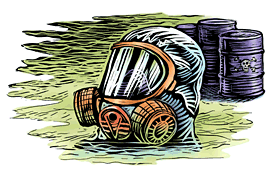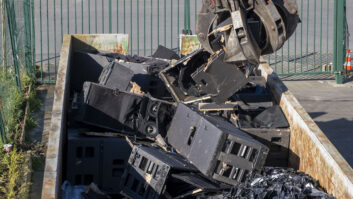
Studies have shown that enjoying your job is one of the keys to a long life. But what if the job you enjoy is reducing your chances to spend your retirement days fishing or just strumming your six-string on your front porch swing? This month, I’ll talk about some of the visible and less-visible dangers that we in the tech lane may be exposed to every day.
BETTER AUDIO THROUGH CHEMICALS
Every job has its hazards, although the pursuit of audio does not carry the same levels of job peril as, say, maintaining a nuclear reactor. We’re less likely to pay much attention to the dangers, big or small, until some life-changing event brings self-preservation to the forefront.
The most obvious hazards are listening too loud for too long, carpal tunnel (from “mousing” around), etc. And anyone involved in repairing, modifying and tweaking gear always thinks twice about the possibility of lethal electrocution, especially once we’ve removed that panel with the “no serviceable parts inside” warning tag. However, far less obvious are the long-term effects of exposure to our trade’s nasty chemicals: solder, flux, flux remover, burnt insulation, pot/switch cleaners, etc.
BC (BEFORE CONCERN)
I was sucking up solder fumes before puberty, wrapping solder around my finger to make “Slinkies” and weaving it into interesting “wire” sculptures — all before having any idea that such “play” would result in a life-threatening illness. My fingers would be gray from whatever rubbed off; I didn’t wash my hands before eating — all the stuff I bug my kids about now. But combine that with the occasional lingering aches and pains, a friend’s illness or the death of a peer and it’s enough to make me stop and wonder.
THE WHIFF (MY TWO SCENTS)
Scents of all sorts trigger memories — including many fond ones — like the smell of warm tube gear, old fashioned solder flux or even a reel of recording tape (especially one that is freshly baked). Some of these aromas are the result of “outgassing” — chemical reactions that are still in the curing phase (like that new-car smell) or are accelerated by heat.
Batteries should be removed from equipment when not in use. None of us do it, but we should, due to the corrosive chemicals that are released into the confined space of a battery compartment. When was the last time you actually had a reliable flashlight? The outgassing corrodes switch contacts and can degrade nearby electronics unless they are isolated from the battery compartment. It’s also why backup batteries are soldered in place instead of being easily removable. Better to have no battery socket than a cheap, unreliable one.
As so much of our hunting and gathering now happens via Internet, chemicals are shipped to us and arrive with all sorts of warning documentation: “This product contains ‘xxx,’ a chemical known to cause cancer.” These notices are not just extra packing material; they should motivate everyone to do what it takes to improve their health and safety.
SIMPLE STEPS
The amount of soldering I’ve needed to do has varied widely over the years. When my company did wiring and installations, every employee had a fan. Much less soldering was required during the DAT/DA-88/ADAT heyday, but that has changed in recent years with the increasing interest in refurbishing and restoring vintage gear.
I’ve always had a fan at my bench that draws the fumes away from my face. It’s amazing how funky the blades can get during a year, covered with gunk and toxic crud that otherwise would have wound up in my lungs. You can use any type of fan from a small computer-style model up to the more sophisticated filtered type. An exhaust hood would be ideal, but at least a fan moves the noxious fumes around, lowering their concentration in the work area.
FLUX AROUND
Until recently, the wire solder we’ve used was a mixture of approximately 60 percent tin and 40 percent lead with a flux core. Flux is a chemical concoction used to remove existing oxidation from metal surfaces and/or minimize oxidation when the work is heated. Use of flux increases “wetting action” — a solder’s ability to flow, spread and bond to the electrical connections. When all is well, the connection is nice and shiny.
Residual flux can absorb moisture and eventually acquire resistive properties, which is undesirable around the FET in your 1176, for example. I recently restored an early Mesa Boogie Mark-I guitar amp and it had many dark reddish-brown blobs of flux around each connection. After all the repair work was complete, I scraped off as much old flux as possible and washed what remained with something stronger than organic flux cleaner (water).
THE OFFICIAL WORD(S)
Back in the ’80s, chlorofluorocarbons (CFCs) were used as propellants and refrigerants, Freon being the most widely known. Because CFCs were blamed for depleting the ozone layer, alternatives were needed and that’s how organic, water-soluble and no-clean fluxes came into being. A factory can generate a lot of effluent as contaminated flux remover and if it’s in a non-toxic form, that waste water can easily be recycled.
Four years ago, the European Union adopted the “Restriction of Hazardous Substances” (RoHS) directive, which took effect on July 1, 2006. RoHS compliance requires that products be made without lead (and other hazardous chemicals) so they can be recycled without contaminating the environment. This forced many American manufacturers to get with the program if they wanted to sell their products to EU countries.
One manufacturer recently released a new model that looked very similar to its discontinued predecessor, with one or two minor feature upgrades. As I discovered, the change was primarily made for RoHS compliance. Not only did RoHS get the lead out of solder, but also out of components such as resistors, capacitors, ICs, etc. Last summer, many of the “old” parts quickly became obsolete during the transition, resulting in some shortages until the RoHS versions re-emerged with new part numbers.
ALLOY ALLIES
Of the many unleaded solder alloys, the two main variations are tin/silver/copper and tin/copper. Both have higher melting points and tend to not make a connection as “pretty” as lead-based solder and its flux. As mentioned, there have been organic fluxes since the late ’80s that are water-soluble and others that do not require cleaning. The problem with organic flux is that it can support life, as in mold. It must be cleaned immediately after the work is done with a decent amount of elbow grease and a brush; otherwise, it leaves a whitish-gray film.
On the upside, it’s good to know that washing a PCB with water is acceptable (assuming power is not applied). The next time someone spills a beverage onto your console/keyboard/reverb/CPU, pull the plug and/or batteries ASAP (and drives, if applicable) and start scrubbing. Then bake at a low temperature until all traces of moisture are gone and your gear’s chances of recovery are very good.
MANUFACTURING
I spoke with Dave Hill of Crane Song and visited Dan Kennedy at Great River Electronics to get a feel for their day-to-day realities. Both companies specialize in products with a discrete analog audio signal path, which means that traditional through-hole components are likely to be the key ingredients. Each company has slowly been integrating surface-mount technology, such as digital control circuits, digital conversion or, whenever it becomes necessary, to conserve “real estate” by using smaller components.
Keep in mind that boutique audio gear is a low-volume product as compared to consumer electronics — hundreds of thousands of cell phones, DVD players and computers are almost entirely fabricated by machine, while audio PCBs are often hand “stuffed.” PCB production can easily be automated, but it’s a huge investment for the manufacturer because all of the electronic components must be purchased in advance for a board run that takes advantage of “volume pricing,” typically 500 pieces minimum.
Grace Designs took this bold step for the first time a few years ago. It’s a big gamble that requires some confidence in the future. You have to weigh sitting on stock for perhaps a year against the savings. Hill took a very different but equally bold step by purchasing the surface-mount production equipment and launching his company on a pair of learning curves: programming the equipment and becoming RoHS-compliant.
When I had hoped to glean a few product suggestions from Hill and Kennedy that would be applicable to readers, I got the impression that the new solders and fluxes were better than the first-generation alternatives, but that both manufacturers are continually looking for improvements in the next generation of materials. I also learned that what happens on the production floor is different from the prototype lab, where each of these wizards still uses conventional solder.
I use three different solder types and can make them all work, but it takes some time to adjust. Many of my repair jobs involve vintage gear, so I have to use something stronger than water for cleaning residue. Alcohol leaves a film that I don’t like, but acetone (the key ingredient in nail polish remover) works well. I’ve got an exhaust fan that vents outside. After one or two passes with a brush, I go back with cotton swabs to remove what remains in performance-critical areas.
CLEANING UP
One of the nice things about having vintage audio gear is keeping still-usable products out of dumpsters and landfills. In that sense, by loving vintage gear, we all do our small part to keep hazardous materials from contaminating the environment. And that’s a good thing for everyone.
After reading all of the warning labels and surfing the Net, Eddie is thankful to be alive. As for giving up and letting go, he says, “Life is good when I’m on the wagon, but it’s so easy to fall off.”
UNDERSTANDING THE MSDS
OSHA regulations require that employers maintain safety information about hazardous chemicals used or present in the workplace. Such knowledge begins with a Material Safety Data Sheet (MSDS). Existing in written or electronic form, an MSDS informs users about any possible hazards inherent with a chemical. Provided by the manufacturers, importers or distributors of both generic (such as acetone or isopropyl alcohol) and proprietary (i.e., Caig DeoxIT) products, the MSDS must be readily available in the workplace. Typically, MSDS pages contain handling and storage precautions, exposure protection methods, hazard identification (inhalation/skin or eye contact/ingestion/prolonged exposure), chemical properties, first aid/fire-fighting measures, spill/accidental release procedures, disposal considerations and more. Readily found as .pdf documents on the Internet, a binder of printed MSDS forms is a simple, inexpensive step toward creating a safe work environment.

